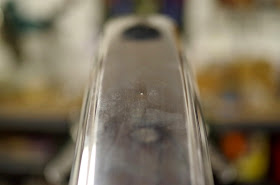by Scott
My vacation this year was a long planned trip to Iceland with my wife. Iceland is a place that I have wanted to visit ever since reading the book
Arctic Odyssey by Richard Sale and Tony Oliver. We had two and a half weeks, and we planned only to visit the lower southwest part of the country. We didn't have time to try and ride around the island, so we wanted to give ourselves lots of time to explore an area.
I won't bore you with the day-to-day ins and outs of our trip, but I will share some thoughts and photos of an amazing place.
If you are looking for wide open spaces to ride, this is the place. The road above was only a couple of hours from Reykjavik and was our first lunch stop of the trip. While the road was paved here, the hill leading up to it was the first of the gravel/dirt roads we encountered on the trip.
Our first campground was in Grindavik. This was the last stop for many cyclists, as the international Airport and the Blue Lagoon spa were 3 hours and 20 minutes away, respectively. Here we encountered the largest number of cycle tourists, including this French couple traveling with a mountain tandem and trailer. (Most of the tourists we met were from Europe. We didn't meet a lot of North Americans.)
We knew food would be an issue on this trip. Prices are high for goods in Iceland - we knew that going in. We tried to carry at least an extra dinner on us along with some muesli and some cheese and buns for lunch. On one occasion, Melissa came up with the idea for Mexican junk food night: refried beans, cheese sauce and taco sauce all heated up as a layer dip, followed by chips and Icelandic pop to wash it down. Vegetarian, easy to find at the grocery store and very filling.
We camped 9 nights out of 13 on the road. The campsites ranged from wide open fields close to town to the caldera of an extinct volcano in the Westman (or
Vestmannaeyjar) Islands. At the caldera, we had to put the tent up between upright lava rocks and behind mounds of earth. The great thing about the camp sites was the camp kitchens that almost all of them had. An enclosed area with hot plates, tables, electricity and most of all, heat, was very welcome after a long day on the road, or just for the fact that we didn't have to cook bent over a Primus stove in the wind.
.JPG)
Finally, the weather is always something people speak of. We had the full mix of weather: rain, storms, wind and, finally, sun that came out at the best possible times. We went late in the season for cycling in Iceland, and you could tell by the distinct lack of other cyclists by the end of our trip in early September. But even in the worse weather, Iceland had a beauty and an energy that we have not found any where else and we are planning a return trip. It has so much to see and so many different eco-systems and geographic features that I think it can take up a lot of vacations in the years to come.
We flew Iceland Air, and they were great with the bikes. They only charged us $40 per bike, per direction, and they treated our boxes with great care and attention. In fact, everyone in Iceland was very respectful of bikes, giving us lots of room on the roads and always eager to help with suggestions.
For those wondering about gear details, Melissa took a Camargue and I took a prototype frame, the details of which I am sworn to secrecy. We ran 26 x 1.95 WTB all terrain tires which were great for all the roads we encountered. We used a mix of panniers, frame bags and dry bags to carry our "light packing" load.
This was a dream vacation- great riding, lovely food, great beer and wonderful people.





















.JPG)
.JPG)
.JPG)
.JPG)
.JPG)
.JPG)
.JPG)






